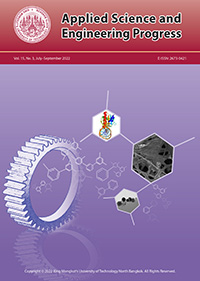Evaluation of Eutrophication State of Mae Kuang Reservoir, Chiang Mai, Thailand by Using Carlson’s Trophic State Index
Main Article Content
Abstract
Eutrophication is an event that occurred when the lakes have a high growth rate of phytoplankton and causing deterioration of water quality. In this work, we use Carlson’s Trophic State Index (CTSI) to evaluate the situation of eutrophication of Mae Kuang Reservoir for the first time. Three parameters, i.e., total phosphorus, chlorophyll-a, and water transparency were used to calculate CTSI. The results showed that the reservoir has started to be eutrophic. In June and October, the ranges of the CTSI were 49.26–59.60 and 49.07–56.04, respectively, which indicated a low eutrophic state of the reservoir. However, in this primary eutrophic condition, the water quality was not bad, and the living organisms can survive. The CTSI is a valuable and simple alternative method for monitoring and estimating lake ecosystems' eutrophic status.
Article Details
References
D. Harper, “What is eutrophication,” in Eutrophication of Freshwater. 1st ed., Dordrecht, Netherlands: Springer, 1992, pp. 1–28.
D. W. Schindler, “Recent advances in the understanding and management of eutrophication,” Limnology and Oceanography, vol. 51, pp. 356– 363, Jan. 2006.
S. R. Carpenter, “Submersed vegetation: An internal factor in lake ecosystem succession,” The American Naturalist, vol. 118, pp. 372–383, Sep. 1981.
V. H. Smith, “Eutrophication of freshwater and marine ecosystems: A global problem,” Environmental Science and Pollution Research, vol. 10, pp. 126– 139, Mar. 2003.
R. E. Carlson, “A trophic state index for lakes,” Limnology and Oceanography, vol. 2, pp. 361– 369, Mar. 1977.
E. Naumann, “The scope of chief problems of regional limnology,” Internationale Revue der gesamten Hydrobiologie und Hydrographie, vol. 21, pp. 423–444. Jan. 1929.
G. Maryam, R. Mohammad, M. Serajian, O. Kaveh, E. Saeid, and P. S. Vijay, “Determining the eutrophication state of ecbatan reservoir using Carlson index,” American Journal of Engineering and Applied Sciences, vol. 11, pp. 491–500. Apr. 2018.
N. B. Deepa and S. Pradeepkumar, “Assessment of trophic state of lakes in term of Carlson’s trophic state index,” International Journal of Innovative Research in Sciences, Engineering and Technology, vol. 3, pp. 14297–143021, Jul. 2014.
C. Ariyadej, “Correlation of some nutrients and phytoplankton distribution in Mae Kuang Dam Reservoir, Chiang Mai,” M.S. thesis, Chiang Mai University, Chiang Mai, Thailand, Sep.1996.
Y. Peerapronpisal, W. Sonthichai, T. Somdee, P. Mulsin, and E. Rott, “Water quality and phytoplankton in Mae Kuang Udomtara reservoir, Chiang Mai, Thailand,” Chiang Mai Journal of Science, vol. 26, pp. 25–43, Jun. 1999.
APHA, “4500-P phosphorus,” in Standard Methods for the Examination of Water and Wastewater. 19th ed., New York: American Public Health Association Inc. 1995, pp. 146–162.
J. F. Wintermans and A. DeMots, “Spectrophotometric characteristics of chlorophyll a and b and their pheophytins in ethanol,” Biochimica et Biophysica Acta, vol. 109, pp. 448–453, Nov. 1965.
D. M. Roberson, S. G Schladow, and G. C. Holdren, “Long-term changes in the phosphorus loading to and trophic state of the Salton Sea, California,” in Proceedings a Symposium Celebrating a Century of Symbiosis Among Agriculture, Wildlife and People, 1905–2005, 2008, pp. 21–36.
D. F. Watson and G. M. Philip, “A refinement of inverse distance weighted interpolation,” Geoprocessing, vol. 2, pp. 315–327, 1985.
J. C. Miller and J. N. Miller, Statistics for Analytical Chemistry, 3rd ed., Chichester, England: Ellis Horwood, 1993.
R. A. Vollenweider, R. Marchetti, and R. Viviani, “Marine coastal eutrophication : The response of marine transitional systems to human impact : Problems and perspectives for restoration,” in Proceedings of an International Conference, 1990, pp. 1–20.
P. Mulsin, “Phytoplankton biovolume and water quality in reservoir of Mae Kuang Dam, Chiang Mai,” M.S. thesis, Chiang Mai University, 1997.
I. Seekhao, “Monitoring of microcystins from toxic blue green algae and water quality in Mae Kuang Udomtara Resevvoir, Chiang Mai province, year 2004–2005,” M.S. thesis, Chiang Mai University, 2006.
W. M. Mooij, J. H. Janse, L. N. D. S. Domis, S. H. lsmann, and B. W. Ibelings, “Predicting the effect of climate change on temperate shallow lakes with the ecosystem model PCLake,” Hydrobiologia, vol. 584, no. 1, pp. 443–454, Jun. 2007.
L. Peperzak, “Climate change and harmful algal blooms in the North Sea,” Acta Oecologica, vol. 24, pp. S139–S144, May 2003.
X. Chen, H. Li, J. Hou, X. Cao, C. Song, and Y. Zhou, “Sediment–water interaction in phosphorus cyclingas affected by trophic states in a Chinese shallow lake (Lake Donghu),” Hydrobiologia, vol. 776, pp. 19–33, May 2016.
S. Ihnken, A. Eggert, and J. Beardall, “Exposure times affect photosynthetic parameters in algae,” Aquatic Botany, vol. 93, no. 3, pp. 185–194, Oct. 2010.
B. Nesa, A. H. Baird, S. Harii, I. Yakovleva, and Hidaka M, “Algal symbionts increase DNA damage in coral planulae exposed to sunlight,” Zoological Studies, vol. 51, no. 1, pp. 12–17, Jan. 2012.
Y. Hailin, F. Hongxiang, X. Ligang, W. Yongming, L. Lizhen, and Y. Zhong, “Poyang lake wetland ecosystem health assessment of using the wetland landscape classification characteristics,” Water, vol. 11, p. 825, Apr. 2019.


